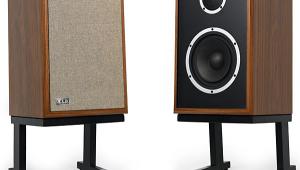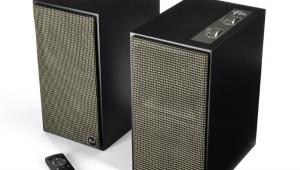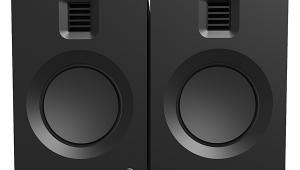ELAC Adante AS-61 Loudspeaker Review Page 2
Despite its low-end limits, the AS-61’s bass was tight and boom-free, so there was promise there. It’s no secret that the room itself, and where speakers and the listeners are positioned in the room, are just as important to the bass response you hear as the speakers themselves. My close measurements on the speaker taken near the 8-inch passive bass radiator using the Omnimic measurement system (not a laboratory-grade instrument, but useful and sufficient to the task here) showed that without any help from the room the AS-61 falls off steeply below 50 Hz and its -6dB point is just over 40 Hz. The room can usually be counted on to offer at least some gain in the low bass, though that depends on the room’s size, configuration, and any openings to adjoining spaces. In a space as big and open as mine, the benefit is limited.
 It was no surprise, then, that when I moved the speakers a foot closer to the wall behind them and a foot closer together (and the listening seat forward by roughly the same distance), I got better and sometimes even surprising results. The bass tightness remained, but it was now enhanced by a rewarding increase in bottom-end punch.
It was no surprise, then, that when I moved the speakers a foot closer to the wall behind them and a foot closer together (and the listening seat forward by roughly the same distance), I got better and sometimes even surprising results. The bass tightness remained, but it was now enhanced by a rewarding increase in bottom-end punch.
Below roughly 45 Hz, there was still little useful response. But there’s a solution for that, one strongly recommended for any standmount or bookshelf speaker, particularly in a big room: a subwoofer.
ELAC sent us its Adante SUB3070 subwoofer ($2,500), a relatively compact 77-pounder equipped with two 12-inch, aluminum-cone drivers and a 1200-watt (maximum) BASH amplifier in a sealed cabinet. A first sample proved faulty (a likely victim, perhaps, of an early production run), but a replacement for the defective sample worked beautifully.
The SUB3070 has a setup feature designed to minimize your room’s effect on the sub’s response. You first download ELAC’s Sub Control app and link the phone with the sub via Bluetooth. You then hold the phone as close to the woofer as possible and engage the app. This generates a low frequency sweep tone in the sub, which at close distance should result in a near anechoic measurement. You next take a similar measurement at the listening position. The software in the sub then calculates a correction curve that’s applied to the subwoofer. Any errors in your cell phone’s microphone appear in both measurements so the app can compensate for them. It’s all very slick, and no measurement devices apart from your phone are needed. The main shortcoming is that it only optimizes for one position and can’t average readings for multiple seats.

The Sub Control app also provides full remote control for all of the important setup functions, including level and phase, plus four optional, preset tweaks to the corrected response (Normal, Music, Cinema, Night—I used Normal throughout) and eight separate bands of parametric equalization for additional fine tuning. I found this parametric EQ extremely useful, but to employ it effectively you’ll need some sort of external measurement device, such as the above-mentioned $300 Omnimic system from Parts Express that I use for in-room measurements.
After optimizing the sub’s response with the app, the results were exceptional. I threw all of my favorite music selections at it, including pounding drums, deep organ passages, and growling synth bass. Together with the AS-61s, the SUB3070 never left me wanting for more. No small, single sub will fully energize a room as big as mine (by “energize” I mean roll down your socks and turn your belly to jelly). But I heard and felt everything I needed to hear, and then some. The soundtrack from Blade Runner 2049, as played back on an almost full Adante system consisting of the AS-61s, the equally superb AC-61 center ($2,000), the SUB3070, and, as non-ELAC outliers, Revel Concerta bi-pole surrounds, was a visceral experience. Nothing fazed this setup. Even when played at levels I would never use for casual guests, and rarely even for myself (or visiting audio nuts), I didn’t hear a hint of strain or harshness.

Conclusions
I’ve said plenty here about the AS-61’s bass in my rather large listening space. In the speaker and listening positions that best serve both my two-channel music and home theater needs, the AS-61’s bass was tight and well-defined, but lean. But when I moved it closer to the wall behind it, and also moved the listening position forward, everything was in better balance. The bass wasn’t world-beating, but it still should make two-channel music listeners extremely happy.
With the pair of AS-61s in their original positions, supported by a good subwoofer, the situation completely changed. The Adante’s clear, rich midrange and natural high frequency sparkle continued, but was now fully supported to below 30 Hz. With the Adante SUB3070 subwoofer providing the low-frequency grunt needed for my room, I heard a system that could easily challenge far pricier speakers. Used this way (or without a sub for music in medium-sized spaces, up to perhaps 3,000 cubic feet), the ELAC Adante AS-61 earns an enthusiastic Top Pick.




























































